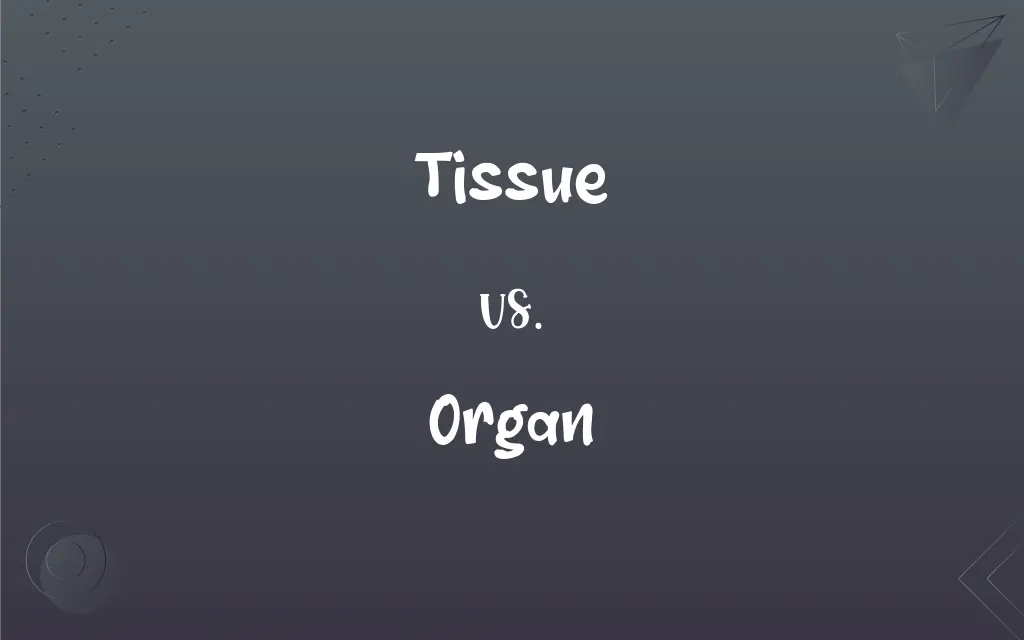Tissue vs. Organ: What's the Difference?
Edited by Aimie Carlson || By Harlon Moss || Updated on October 28, 2023
Tissue is a group of similar cells performing a specific function; an organ is a structure composed of multiple tissues performing a vital role.

Key Differences
Tissue refers to a collection of similar cells and their intercellular substances that work together to perform a particular function. Organ, on the other hand, denotes a more complex structure in the body formed by the combination of multiple types of tissues working in unison. When looking at the hierarchy of biological organization, tissues are the intermediate between cells and organs. For instance, muscle tissue provides contraction and movement, while an organ like the heart uses multiple tissues to pump blood throughout the body.
In our bodies, there are four primary types of tissues: epithelial, connective, muscle, and nervous tissue. Each type of tissue has a distinct role and function. Organs, conversely, utilize a combination of these tissues to perform their tasks. For instance, the kidney, an organ, comprises all four primary tissues working cohesively to filter the blood and produce urine.
The concept of tissue emphasizes the idea of cells working together for a shared function. This collaboration at the cellular level provides the foundational processes and structures for the body to operate. In contrast, the term organ emphasizes the higher level of complexity and coordination, where multiple tissues are synchronized to perform more intricate tasks vital for the survival of the organism.
To understand the relationship between tissue and organ, consider the analogy of building blocks. If cells are the basic units or bricks, then tissues are the walls formed by those bricks. Organs, in this analogy, would be entire rooms or sections of a structure, each with a specific purpose, composed of multiple walls (tissues).
Comparison Chart
Definition
Group of similar cells with a specific function
Structure composed of multiple tissues
ADVERTISEMENT
Complexity
Less complex
More complex
Primary Types
Epithelial, connective, muscle, nervous
Varies (e.g., heart, kidney, liver)
Functional Focus
Specific function (e.g., contraction, protection)
Vital role (e.g., circulation, filtration)
Hierarchy in Biology
Intermediate between cells and organs
Above tissues, part of systems
Tissue and Organ Definitions
Tissue
Tissue is categorized based on structure and function.
Epithelial tissue covers and protects the body's surfaces.
ADVERTISEMENT
Organ
Organ plays a vital role in physiological processes.
The kidney is an organ crucial for filtering and excreting waste.
Tissue
Tissue is a group of similar cells working together.
Muscle tissue enables movement in our bodies.
Organ
Organ operates as part of a larger system in organisms.
The stomach, an organ, is integral to the digestive system.
Tissue
Tissue can connect, protect, or support other structures.
Connective tissue binds the skin to underlying muscles.
Organ
Organ is a distinct body structure with a specific function.
The heart is an organ responsible for pumping blood.
Tissue
Tissue represents a specific functional unit in organisms.
Nervous tissue facilitates communication between different parts of the body.
Organ
Organ can be exterior or interior in location.
The skin is an external organ providing protection and sensation.
Tissue
Tissue forms the building blocks of organs.
Various tissues come together to form the structure of the heart.
Organ
Organ is a composite of different tissues.
The liver, an essential organ, processes and detoxifies chemicals.
Tissue
A fine, very thin fabric, such as gauze.
Organ
An instrument consisting of a number of pipes that sound tones when supplied with air and a keyboard that operates a mechanism controlling the flow of air to the pipes. Also called pipe organ.
FAQs
What is tissue?
Tissue is a group of similar cells that work together to perform a specific function.
Are there different types of tissues?
Yes, there are four primary types: epithelial, connective, muscle, and nervous tissue.
How does an organ differ from tissue?
An organ is composed of multiple types of tissues and performs a more complex role vital to the organism.
How does tissue contribute to the function of an organ?
Tissue provides the fundamental processes and structures that enable the organ's function.
Do all organisms have the same tissues and organs?
No, while many tissues and organs are common across species, there are variations based on the organism's needs.
What is the function of an organ?
Organs perform vital roles, such as circulation (heart) or digestion (stomach), crucial for the organism's survival.
How are tissues categorized?
Tissues are categorized based on structure and function, like muscle tissue for movement.
Can an organ consist of a single type of tissue?
While organs are typically composed of multiple tissue types, a predominant tissue type might dominate their structure.
What's an example of tissue in the human body?
An example is muscle tissue, which facilitates movement.
Are organs always internal?
No, while many are internal, like the heart or liver, some like the skin are external.
Which is larger, tissue or organ?
An organ is larger as it comprises multiple tissues.
What connects different tissues in an organ?
Connective tissue often binds different tissues within an organ.
Can organs regenerate?
Some organs, like the liver, have regenerative capacities, while others, like the heart, have limited regenerative ability.
Are all tissues in an organ identical?
No, an organ typically consists of various tissue types, each contributing to its function.
Can a disease affect both tissue and organ?
Yes, diseases can target specific tissues, affecting the overall function of the associated organ.
Which is more complex, tissue or organ?
Organ is more complex as it consists of multiple types of tissues working together.
Is the skin considered tissue or organ?
The skin is considered an organ, and it comprises various tissue types.
How do tissues come together to form an organ?
Different tissues integrate and coordinate their functions to create the specific role of an organ.
Can organs function independently?
While organs have specific roles, they often depend on other organs or systems for full functionality.
Can a tissue exist outside of an organ?
While tissues form the building blocks of organs, certain tissues, like connective tissue, can exist outside specific organs.
About Author
Written by
Harlon MossHarlon is a seasoned quality moderator and accomplished content writer for Difference Wiki. An alumnus of the prestigious University of California, he earned his degree in Computer Science. Leveraging his academic background, Harlon brings a meticulous and informed perspective to his work, ensuring content accuracy and excellence.
Edited by
Aimie CarlsonAimie Carlson, holding a master's degree in English literature, is a fervent English language enthusiast. She lends her writing talents to Difference Wiki, a prominent website that specializes in comparisons, offering readers insightful analyses that both captivate and inform.































































